Links to Bibliographies
Eddie Jones
--- Introduction
--- The Space Warriors
--- Terra Astra
--- All Covers
--- Terra Astra #1-100 (i)
--- Terra Astra #101-200 (i)
--- Terra Astra #201-300 (i)
--- Terra Astra #301-400 (i)
--- Terra Astra #401-500 (i)
--- Terra Astra #501-561 (i)
--- Enterprise (i)
--- Dumarest Saga (i)
--- Raumschiff Orion (i)
--- Star Trek
--- Enterprise - Williams-Verlag (i)
--- Enterprise - Terra Astra (i)
--- Raumschiff Enterprise (i)
--- Other Star Trek Covers (i)
--- Perry Rhodan
--- Dutch Magazine (i)
--- Other Perry Rhodan Covers (i)
--- Other Publication Series
--- Altair Fantascienza (i)
--- Bastei SF Taschenbuch (i)
--- Delta Science Fiction
--- Dragon: Söhne von Atlantis (i)
--- Fischer Orbit (i)
--- Heyne Verlag (i)
--- Orbit (i)
--- Orion
--- Sphere Books (i)
--- Venture SF (i)
--- Vision of Tomorrow (i)
--- Other Covers
--- Books - UK & US (i)
--- Books - Belgian & Dutch (i)
--- Books - German (i)
--- Books - Italian
--- Books - Spanish
--- Books - Other Countries
--- Fan & Convention Publications
--- Magazines (i)
--- Interior Artwork
--- Miscellanea
--- Biographical Sources (i)
The Big Three
--- Isaac Asimov
--- Arthur C. Clarke
--- Robert A. Heinlein
Science Fiction and Fantasy Series
SF Universes and Fantasy Worlds
A Brief Biography of Eddie Jones (1935-1999)
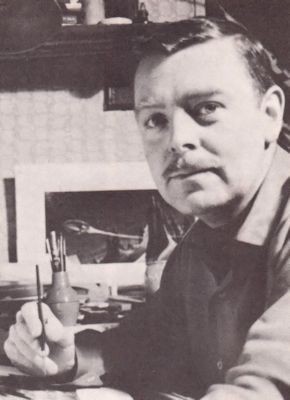 |
| Eddie Jones, c.1969 |
Jones was a self-taught artist and painted with little or no detailed preparation. Although he generally working in gouache, he also used acrylic, watercolours and sometimes an air-brush.
"I never sketch out a cover to any detail before hand. I paint straight onto the board. I read a novel pictorially, so in a sense, when I come to do the illustration, I've already seen it. My inspiration comes from the fiction itself, so in most cases I'm relying solely on the authors."
Eddie Jones, from an interview with Vortex magazine, 1977
He was known for his imaginative and richly coloured depictions of diverse spaceships and starscapes, as well as lost alien cities rich in technology, people and alien creatures.
Jones considered himself an artist of Science Fiction rather than Science Fact, but he also appreciated opportunities to indulge his interest in Swords & Sorcery when they presented themselves. He included John Schoenherr and Jack Gaughan amongst his influences, and also admired the work of Chris Foss: "I don't think that people like Chris Foss influence me, but I know that they have a winning formula."
"I do other things than science fiction - obviously, I've got to. I do military uniforms, I do a lot of prints of military uniforms, but I still go back to science fiction because I love it. . . . I came into science fiction through fandom many, many years ago and I found that I liked the people, I liked the fiction, and I was doing illustrations of other sorts, and why not go into science fiction? I can now express my feelings for the literature."
Eddie Jones, comments from a discussion panel at Noreascon, 1971
As well as drawing and painting science fiction, fantasy and miltary subjects, he collected, manufactured and painted military miniatures.
Eddie Jones used a number of identifiers on his work, including 'Eddie' (more common on early work and fan art), 'EDDIE JONES' (often found on work for an English-speaking market), 'S. Fantoni' (on Star Trek paintings) and an EJ (not ED) monogram (on covers for the German market). In some cases, cover artwork was published without a signature or initials.
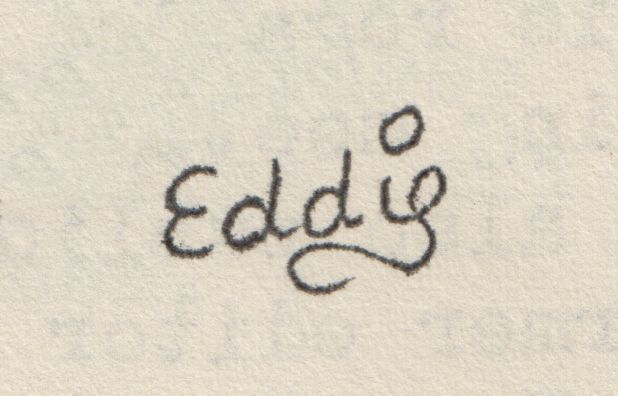 |
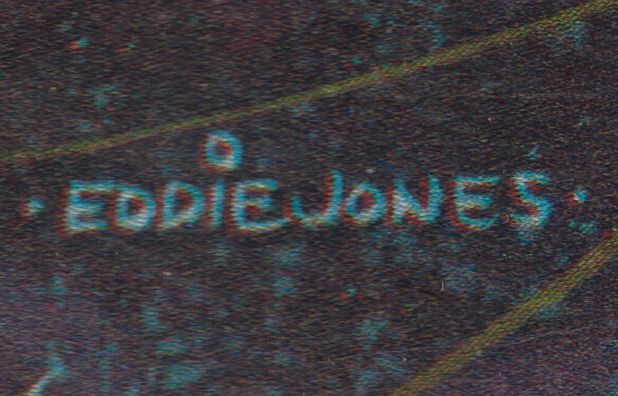 |
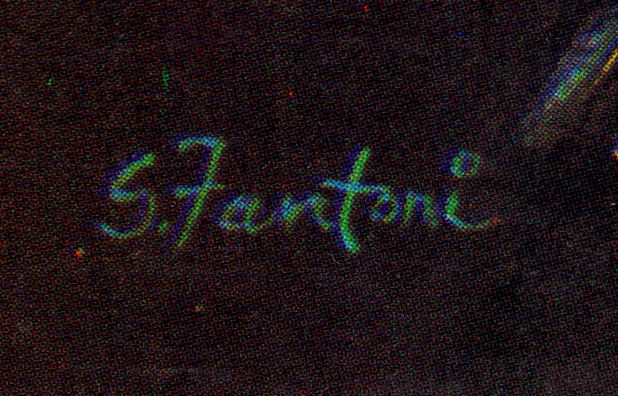 |
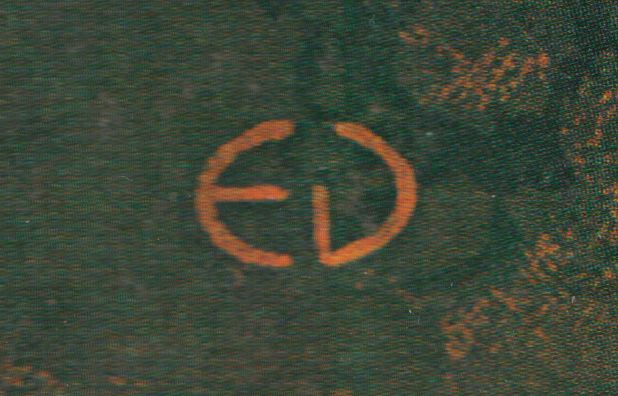 |
Early Years
Edward John Jones was born on 18 January 1935 in Bootle, near Liverpool. He attended Bootle Grammar School for Boys but left, aged 16, to work for an advertising agency as a trainee artist. Jones transferred to the production department not long after, where over the next ten years he learned his trade as a print buyer. He then left to join the RAF (National Service?), but returned to the agency as a production manager. While this left little time for painting, it did provide useful background knowledge for the commercial illustrations he was to produce in later years.
Jones's interest in science fiction began at school where he became an avid reader of magazines such as Amazing Stories, Fantastic Adventures and Planet Stories. He discovered SF fandom in 1953 through an advertisement for the newszine Operation Fantast and then learned of the Liverpool Group of SF enthusiasts. The fanzine scene at the time was thriving and encountering it prompted him to submit his own illustrations for publication, first in The Medway Journal and later in Ploy and Binary. After discovering fanzines, it was a natural step to meet other fans by attending SF conventions, beginning with Eastercon at Kettering in 1956. A year later he was involved in the organisation of the programme for Loncon, the 1957 World Science Fiction Convention, and also provided the cover illustration for Songs from Space, the earliest known book of British filk songs (and perhaps the earliest filk book ever printed).
Fandom continued to be the focus of Jones's artistic output throughout the fifties and sixties. His illustrations appeared in a wide range of fanzines and convention publications. (A listing is currently being compiled for inclusion in Eddie Jones - An Illustrated Bibliography.) He was also a founding member of the British Science Fiction Association in 1958 and contributed seven illustrations for the cover of its journal, Vector.
First Sales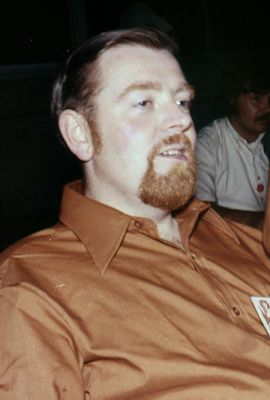 |
| Eddie Jones at Noreascon, 1971 Photograph © Len & June Moffatt Courtesy of The Los Angeles Science Fantasy Society |
Further success followed with an untitled back cover for Nebula Science Fiction (No.20, March 1957) and interior illustrations for Suicide Squad by Robert Presslie (No.39, February 1959) and Imbalance by William F. Temple (No.40, May 1959). Jones finally broke onto the front cover with a series of full-colour illustrations for Nebula Science Fiction - see issues 36 (November 1958), 38 (January 1959) and 40 (May 1959).
"The art has changed dramatically. When I started, a rocket ship was a cigar with fins, or a ball, or two balls connected. Today, it's more like a scrapyard in space. Between the two, the artwork went through a phase when everybody was doing photographic abstracts. That was when I was first thinking seriously about illustration, and I went out and took some abstract photographs. That's how I first came into illustration, through the lens of a camera."
Eddie Jones, from an interview with Vortex magazine, 1977
The cigars with fins can be seen in both New Worlds and Nebula, but the abstracts heralded Jones's first appearance in paperback. Four covers for Badger Books' science fiction series in 1959, beginning with Space-Borne by R.L. Fanthorpe (S.F.20) and ending with The Other Side of Night by Paul Charkin (S.F.24), were a colourful if curious mixture of photograph and paint with an entirely different character to both his earlier and later work. The following year another Badger title, Supernatural Stories No.30, featured an Eddie Jones cover more in line with what would, in the 1970s, become his instantly recognizable style.
Making a Name
The 1960s progressed with a stream of fanzine contributions and occasional professional sales of covers and interior illustrations to magazines. Jones had been contributing to Charles Partington and Harry Nadler's fanzine Alien, and in 1966 he was asked to provide the cover for the first and only issue of its semi-prozine successor, Alien Worlds. This led to a commission for a series of four covers for Nadler's next project, L'Incroyable Cinema, a movie-focused magazine that ran from 1969 to 1971. 1966 also saw Eddie Jones break into the German market with a series of illustrations for the cover of the German fortnightly SF magazine Utopia Zukunftsromane.
Jones was nominated for the 1962 Trans-Atlantic Fan Fund (TAFF) election but lost to Ethel Lindsay. The TAFF was conceived to develop closer links between European and North American fandoms. The winner received funding that allowed them to attend a convention on the other side of the Atlantic. Jones was nominated again in 1969 alongside Bob Shaw and this time won the race. Shortly before the results were announced, Ted White resigned his place as Fan Guest of Honour at the World Science Fiction Convention (St. Louiscon) in favour of the TAFF winner, further adding to the prestige of the win.
"A list of Eddie's artwork is most impressive. Apart from the Castle Con, he has designed two Program Booklets for British cons; has been a fanzine illustrator since 1953 in most British, American, Belgian and German fanzines; has illustrations in professional magazines from NEBULA through NEW WORLDS, SCIENCE FANTASY, BADGER [BOOKS], German PB covers, IF, Arkham House, and even Bubble Gum cards! His latest venture is to produce the covers and interiors for the new British prozine, VISION OF TOMORROW."
Ethel Lindsay, from 'Jones the Fan' in St. Louiscon Program & Memory Book, 1969
Some of the items listed above have been traced for the bibliography. "German PB covers" may be a reference to Utopia Zukunftsromane, but details of his contribution to Science Fantasy magazine are unknown at the time of writing. In Vulture of the Void, Philip Harbottle notes that up until then "his biggest commercial success had been a series of Bubble-Gum cards (on the line of Mars Attacks) but these were not widely known to be his". Initially recruited by Harbottle to produce cover and interior illustrations for Vision of Tomorrow, beginning with Issue 2 (December 1969), Jones was promoted to Art Consultant for Issue 6 (March 1970) and was responsible for the majority of interior illustrations from then on until the final issue in September 1970. He also produced interior illustrations for sister publication Sword and Sorcery, edited by Kenneth Bulmer, which folded before its first issue was published when Vision of Tomorrow lost its distribution deal with New English Library.
The Big Break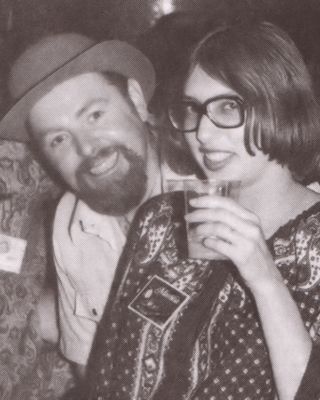 |
| Eddie and Marsha Jones, 1978 Photograph © Charles N. Brown |
Jones travelled to Heidelberg, Germany in 1970 to attend the World Science Fiction Convention. Heicon was important for him for a number of reasons. Not only did the cover of the Heicon programme book feature one of his illustrations, he was also nominated for the Hugo Award for Best Professional Artist. Schlück arranged for him to meet a number of publishers and the resulting offers of work allowed Jones to resign from his job at the advertising agency to work full-time as a freelance artist.
Arthur Moewig Verlag (later Pabel-Moewig) were so impressed with Jones's work that they decided to use their new magazine Terra Astra as a vehicle for his illustrations. The covers for this weekly magazine would be the backbone of his output for over a decade. Bastei-Verlag also commissioned Jones to produce the covers for their new Science-Fiction-Taschenbuch series. Back at home, Sphere Books started to use Jones's illustrations for the covers of some of their science fiction paperbacks. Beginning in 1972, Jones also produced the covers for Fischer Verlag's new science fiction series, Fischer Orbit.
Jones was nominated again for the Hugo Award for Best Professional Artist in 1971 at the World Science Fiction Convention (Noreascon) in Boston. It is possible that it was here that he met Marsha Elkin, a literary agent and one of the organisers of the convention's art show, although they may have met previously St. Louiscon in 1969 or at Heicon in 1970. Whichever is the case, they became a couple and were married in Liverpool on 11 November 1972. The Joneses moved across the Mersey from Bootle to Birkenhead soon after.
Marsha was married to Charles Brown during the 1960s and had co-edited Locus, the legendary newszine. Well-known to U.S. fandom, she had served on convention committees and organised several art shows. Later, in the U.K., she ran numerous art shows at Eastercon and Novacon, as well as at the World Science Fiction Convention (Seacon) in 1979.
A New Enterprise
A new commission came from Williams Verlag in 1972. This was for 13 covers for Enterprise, the German translations of James Blish's short stories based on the scripts of episodes of the original Star Trek television series. The covers came to the attention of Blish's American publisher, Bantam Books, who used them for some of their own Star Trek books. The television series aired in Germany in 1973. Bild und Funk, the German TV guide, used eight illustrations by Jones as part of their build up to the screening. These were issued in a limited edition portfolio by the Andromeda Book Co. in 1976.
In 1975, Terra Astra reprinted the German translations, using a combination of the Williams cover art and some new illustrations Jones produced specifically for them. By the end of 1977 he had produced a total of 22 Star Trek covers plus eight black and white interior illustrations. He went on to do three more covers for Pabel's Terra series, two for Heyne's Star Trek: The Next Generation series and six for The Best of Trek series edited by Walter Irwin and G.B. Love.
Many of Jones's Star Trek illustrations were signed 'S. Fantoni'. This pseudonym was a reference to the Knights of St. Fantony, a fannish jest of sorts that originated in 1957, as an entertainment at Eastercon, when the Cheltenham Science Fiction Circle created an elaborate ceremony as a leg-pull to 'honour' their friends in the Liverpool Group. The ceremony was repeated at Loncon later in 1957 with a new set of 'inductees' and reappeared periodically over the next 20 years at several more conventions. Eddie Jones was one of the original Knights inducted in 1957 and later rose to the dizzying heights of Knight Armourer.
In Demand
The following years were a busy time for Jones. He exhibited at a month-long science fiction symposium, Beyond This Horizon, which was held at the Sunderland Arts Centre in 1973 and also provided the cover art for an anthology of works by writers, poets and artists involved in the event.
His workload for Terra Astra publisher, Pabel, was doubled in 1976 when the Raumschiff Orion series of stories was spun-off as Orion, a separate weekly magazine. He was painting 10-12 covers per month and was also re-selling illustrations from his back-catalogue to other publishers in the Netherlands, Spain and Italy - sometimes a painting might be used for four or five different book covers.
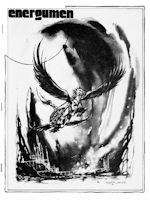 |
"This cover for The Magazine of Fantasy and Science Fiction, with the winged horse and chariot flying over sand dunes and monolithic rocks, has a story behind it. Originally, I did a painting very similar, but involving an icy landscape, all done in blues. That was on show at St. Louis, and six months later the author Lester del Rey indirectly phoned me from America and asked me if I'd produce it for him. I told him that I'd do it in different colours. So I painted it, sent it to Lester, and he wrote a story around the artwork. This has happened to me a few times, because I like to tell a story in the painting. In answer to the question which you're going to ask me: No, I couldn't become a writer, even if I had to." Eddie Jones on the creation of The Dawn Rider, from an interview with Vortex magazine, 1977 |
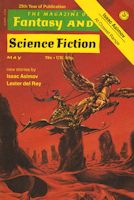 |
Jones was also involved in occasional special projects. One of these was Conquest of the Amazon by John Russell Fearn, an illustrated chapbook edition published by Philip Harbottle under his Cosmos Science Fiction imprint in 1973. This included artwork Jones had originally produced for a reprint of what was intended to be the first in a series of Golden Amazon novels in the ill-fated Image of Tomorrow magazine which, like Sword and Sorcery, had folded before publication of its first issue due to the demise of Vision of Tomorrow.
Another project was a cover painting for Have You Seen These? by Isaac Asimov, a limited edition collection of short stories issued by the New England Science Fiction Association (NESFA) to commemorate the occasion of Asimov being Guest of Honour at Boskone 11 in 1974. Jones was the official arist for the event and also provided the artwork for the convention programme book. (Interestingly, an article in the programme book notes that he had "started selling covers in America, France and Holland", but to date no artwork from France or Holland has been found from before 1975.)
In 1980, Jones's work was featured in The Space Warriors by Stewart Cowley. This collection of three short stories about the adventures of Boots Walker and Rory Pricer was fully illustrated in colour by a number of well-known artists, with the cover and about two-thirds of the interior illustrations by Eddie Jones and the remainder by others including David Hardy, Paul Lehr, Carl Lundgren and Blair Wilkins.
Hard Times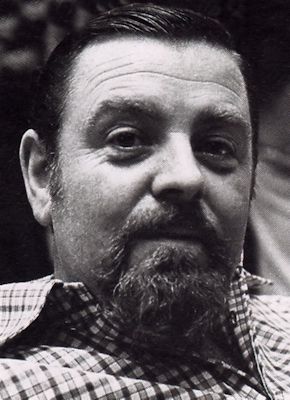 |
| Eddie Jones (Date of photograph unknown) |
The decline in the science fiction market continued year by year and the number of Jones's cover illustrations that were published slowly decreased - from over 100 in 1978 to less than 40 by 1982. After the loss of work from Terra Astra he was almost entirely dependent on sales from his back-catalogue and these too were falling away.
1985 brought two new outlets. First, Rog Peyton, editor for the Hamlyn Paperbacks Venture Science Fiction series, selected the covers from Jones's back-catalogue along with a small number of previously unpublished private commissions that he had painted for friends and for sale at conventions. Goldmann Verlag also reprinted many of his Star Trek covers for their Raumschiff Enterprise series. However, even with these new sources of income, sales of reprints were very low when compared to the seventies and early eighties, and they continued to dwindle until they dried up almost completely in the nineties.
After this little is known for certain, but as Jones battled with alcoholism, Eddie and Marsha Jones divorced, and Marsha returned to the United States; later joining DAW Books as an editor.
Jones left commercial science fiction illustration behind and earned a living painting military miniatures for a model shop in Liverpool, but still continued to paint science fiction scenes for friends and for pleasure. He attended Eastercon in 1999: his first appearance at a convention for over a decade, and was surprised that anyone remembered his artwork or his name. Later in the year, Eddie Jones suffered a stroke and was admitted to a Liverpool hospital where, in the early hours of 15 October 1999, he died following a cardiac arrest during a blood transfusion. He was 64 years old.
Sadly, a volume devoted solely to the art of Eddie Jones was never published. Perhaps this bibliography can be a small step towards remedying that omission.
An Illustrated Bibliography
Links to a bibliography of the art of Eddie Jones can be found below.
It is incomplete and additional items are still being added.
Illustrated sections are indicated by (i).
| Terra Astra | Perry Rhodan | Other Covers |
| All Covers | Dutch Magazine (i) | Books - UK & US (i) |
| Issue #1–100 (i) | Other Perry Rhodan Covers (i) | Books - Belgian & Dutch (i) |
| Issue #101–200 (i) | Books - German (i) | |
| Issue #201–300 (i) | Other Book Series | Books - Italian |
| Issue #301–400 (i) | Bastei SF Taschenbuch (i) | Books - Spanish |
| Issue #401–500 (i) | Delta Science Fiction | Books - Other Countries |
| Issue #501–561 (i) | Fischer Orbit (i) | Fan & Convention Publications |
| Enterprise (i) | Heyne Verlag (i) | Magazines (i) |
| Dumarest Saga (i) | Sphere Books (i) | |
| Raumschiff Orion (i) | Venture SF (i) | Interior Artwork - coming soon |
| Star Trek | Other Magazine Series | Miscellanea |
| Enterprise - Williams-Verlag (i) | Altair Fantascienza (i) | |
| Enterprise - Terra Astra (i) | Dragon: Söhne von Atlantis (i) | Biographical Sources (i) |
| Raumschiff Enterprise (i) | Orbit (i) | |
| Other Star Trek Covers (i) | Raumschiff Orion | |
| Vision of Tomorrow (i) | ||
References
Books and Magazines
- Progress Report 3, ed. Bob Schoenfeld, St. Louiscon, 1969 - see p.11-13 - 'A Statement from Ted White' and 'What's TAFF'
- Program & Memory Book, ed. Bob Schoenfeld, St. Louiscon, 1969 - see pp.23-44 - 'Jones the Fan' by Ethel Lindsay
- Terra Astra, #11, ed. Gunter M. Schelwokat, Moewig, 1971 - see pp.3-4 - 'Eddie Jones' by Thomas Schlück
- Boskone 11, ed. John Howard, NESFA - New England Science Fiction Association, 1974 - see p.12 - 'Eddie Jones'
- Science Fiction Monthly, Vol.1, No.6, ed. Patricia Hornsey, NEL, 1974 - see pp.22-23 - 'The Artist in Science Fiction' by Aune R. Butt
- Vortex, Vol.1, No.5, ed. Keith Seddon, Cerberus Publishing, 1977 - see pp.42-47 - interview with Eddie Jones by Hilary Davidson
- The Encyclopedia of Science Fiction, ed. Peter Nicholls, Granada, 1979 - see pp.322-323 - 'Jones, Eddie' by Jon Gustafson
- Fantasy, #5, eds. Kathy Himmel, Kipy Poyser, OMTAE Press, 1980 - see pp.11-12, 19 - interview with Eddie Jones by Kipy Poyser
- Orbit, #19, edited and published by Kees van Toorn, 1982 - see pp.22-23 - interview with Eddie Jones
- A Biographical Dictionary of SF Artists, ed. Robert Weinberg, Greenwood, 1988 - see pp.157-158 - 'Jones, Eddie' by Richard Dalby
- The Encyclopedia of Science Fiction, ed. John Clute & Peter Nicholls, Orbit, 1999 - see p.648 - 'Jones, Eddie' by Jon Gustafson
- Locus, #466, ed. Charles N. Brown, Locus Publications, November 1999 - see p.66 - 'Obituaries'
- Interzone, #150, ed. David Pringle, pub. David Pringle, December 1999 - see p.5 - Letter to the editors from Rog Peyton
- Perry Rhodan, #2020, ed. Hubert Haensel, Pabel Moewig, May 2000 - see p.x - 'Neue Welten für Terra Astra' by Heiko Langhans.
- SF and Fantasy Artists of the Twentieth Century, Jane Frank, McFarland, 2009 - see pp.290-291 - 'Jones, Eddie'
- Vultures of the Void: The Legacy, Phlip Harbottle, Cosmos Books, 2011 - see pp.302, 315-325 passim, 332, 343, 345
Websites - Biographical Information
- David Langford - Ansible - #148, November 1999 - retrieved 13 March 2016
- David Langford - Rog Peyton - retrieved 13 March 2016
- Encyclopedia of Science Fiction - Eddie Jones - retrieved 12 March 2016
- FANAC - Fan Photos - The FANAC Fan History Project
- Fancyclopedia 3 - Eddie Jones - retrieved 12 March 2016
- Fancyclopedia 3 - Knights of St Fantony - retrieved 12 March 2016
- Fancyclopedia 3 - Marsha Jones - retrieved 12 March 2016
- Memory Alpha - Eddie Jones - retrieved 12 March 2016
- Perrypedia - Eddie Jones - retrieved 12 March 2016
- Science Fiction Writers of America - Eddie Jones ( -1999) - archived 4 December 2003
- SCIFI Inc - Fan Gallery - Marsha Jones - retrieved 12 March 2016
- Wikipedia - Eddie Jones - retrieved 12 March 2016
Websites - Bibliographical Information
- Biblioteca de La Tercera Fundación - Eddie Jones (Reino Unido) - retrieved 13 March 2016
- Catalogo Vegetti della Letteratura Fantastica - Elenco Editori - retrieved 13 March 2016
- Internet Speculative Fiction Database - Eddie Jones - Summary Bibliography - retrieved 12 March 2016
- Memory Alpha - Die Original-Abenteuer von Raumschiff Enterprise - retrieved 13 March 2016
- Perrypedia - Eddie Jones - retrieved 12 March 2016
- Phantastische Büche und Hefte - Terra - retrieved 22 December 2016
- Phantastische Büche und Hefte - Raumschiff Orion - retrieved 13 March 2016
- Phantastische Büche und Hefte - Titelbild von Eddie Jones - retrieved 13 March 2016
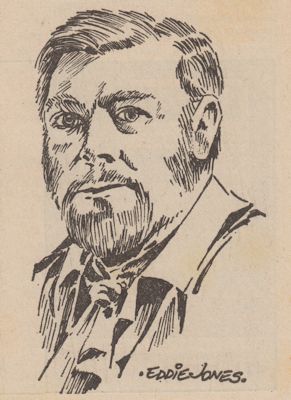 |
| Eddie Jones - Self Portrait (from Terra Astra #11, 1971) |



